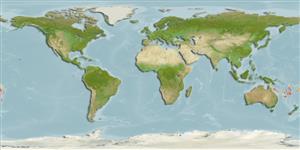Classification / Names
Noms communs | Synonymes | Catalog of Fishes(Genre, Espèce) | ITIS | CoL | WoRMS | Cloffa
Environment: milieu / climate zone / depth range / distribution range
Écologie
marin bathydémersal; profondeur 250 - 320 m (Ref. 28982). Deep-water
Western Pacific: New Caledonia.
Taille / Poids / Âge
Maturity: Lm ? range ? - ? cm
Max length : 13.3 cm SL mâle / non sexé; (Ref. 28982); 11.3 cm SL (female)
Mouth small, upper-jaw length on eyed side 2.8 to 3.1 times in head length. Pectoral fin on eyed side much less than head length in both sexes. Body comparatively deep. Maximum SL about 12.1 cm (Ref 42535).
Life cycle and mating behavior
Maturities | Reproduction | Spawnings | Egg(s) | Fecundities | Larves
Amaoka, K., E. Mihara and J. Rivaton, 1997. Pisces, Pleuronectiformes: Flatfishes from the waters around New Caledonia. Six species of the bothid genera Tosarhombus and Parabothus. p.144-171. In B. Séret (ed.) Résultats des Campagnes MUSORTOM,17, Mém. Mus. Natn. Hist. Nat. 174, 212p. (Ref. 28982)
Statut dans la liste rouge de l'IUCN (Ref. 130435)
Menace pour l'homme
Harmless
Utilisations par l'homme
Outils
Articles particuliers
Télécharger en XML
Sources Internet
Estimates based on models
Preferred temperature (Ref.
123201): 6.4 - 9, mean 8.6 °C (based on 7 cells).
Phylogenetic diversity index (Ref.
82804): PD
50 = 0.5156 [Uniqueness, from 0.5 = low to 2.0 = high].
Bayesian length-weight: a=0.00912 (0.00408 - 0.02036), b=3.05 (2.87 - 3.23), in cm total length, based on LWR estimates for this (Sub)family-body shape (Ref.
93245).
Niveau trophique (Ref.
69278): 3.5 ±0.4 se; based on size and trophs of closest relatives
Résilience (Ref.
120179): Milieu, temps minimum de doublement de population : 1,4 à 4,4 années (Assuming tmax>3).
Fishing Vulnerability (Ref.
59153): Low vulnerability (10 of 100).
